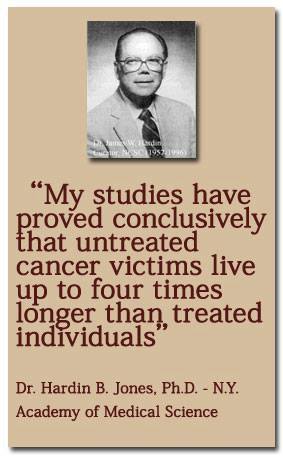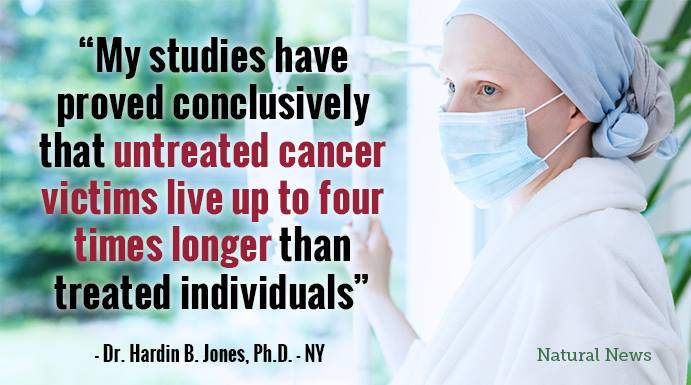Hardin B. Jones,
Ph.D.
[back] Cancer Industry critics
 "My studies have proved conclusively that untreated cancer victims live up to four
times longer than treated individuals. If one has cancer and opts to do nothing at all, he
will live longer and feel better than if he undergoes radiation, chemotherapy or surgery,
other than when used in immediate life-threatening situations."---Prof Jones. (1956
Transactions of the N.Y. Academy of Medical Sciences, vol 6. There is a fifty page article
by Hardin Jones of National Cancer Institute of Bethesda, Maryland. He surveyed global
cancer of all types and compared the untreated and the treated, to conclude that the
untreated outlives the treated, both in terms of quality and in terms of quantity.
Secondly he said, "Cancer does not cure". Third he said "There is a
physiological mechanism which finishes off an individual".) http://www.sickofdoctors.addr.com/articles/medicalignorance.htm
"My studies have proved conclusively that untreated cancer victims live up to four
times longer than treated individuals. If one has cancer and opts to do nothing at all, he
will live longer and feel better than if he undergoes radiation, chemotherapy or surgery,
other than when used in immediate life-threatening situations."---Prof Jones. (1956
Transactions of the N.Y. Academy of Medical Sciences, vol 6. There is a fifty page article
by Hardin Jones of National Cancer Institute of Bethesda, Maryland. He surveyed global
cancer of all types and compared the untreated and the treated, to conclude that the
untreated outlives the treated, both in terms of quality and in terms of quantity.
Secondly he said, "Cancer does not cure". Third he said "There is a
physiological mechanism which finishes off an individual".) http://www.sickofdoctors.addr.com/articles/medicalignorance.htm
Hardin B. Jones, Ph.D. "A Report on Cancer," paper
delivered to the ACS's 11th Annual Science Writers Conference, New Orleans, Mar.
7, 1969.
From: The Hoax Of The "Proven" Cancer Cures by G. Edward
Griffin
Surgery Statistics from Hardin B. Jones, Ph.D.
One of the nation's top statisticians in the field of cancer is Hardin
B. Jones, Ph.D., former professor of medical physics and physiology at the
University of California at Berkeley. After years of analyzing clinical records,
this is the report he delivered at a convention of the American Cancer Society:
In regard to surgery, no relationship between intensity of surgical
treatment and duration of survival has been found in verified malignancies.
On the contrary, simple excision of cancers has produced essentially the
same survival as radical excision and dissection of the lymphatic drainage.
That data, of course, related to surgery of the breast. (Hardin B. Jones,
Ph.D. "A Report on Cancer," paper delivered to the ACS’s
11th Annual Science Writers Conference, New Orleans, Mar. 7, 1969.)
Turning his attention to surgery in general, Dr. Jones continued:
Although there is a dearth of untreated cases for statistical comparison with
the treated, it is surprising that the death risks of the two groups remain so
similar. In the comparisons it has been assumed that the treated and untreated
cases are independent of each other. In fact, that assumption is incorrect.
Initially, all cases are untreated. With the passage of time, some receive
treatment, and the likelihood of treatment increases with the length of time
since origin of the disease. Thus, those cases in which the neoplastic process
progresses slowly [and thus automatically favors a long-term survival] are more
likely to become "treated" cases. For the same reason, however, those
individuals are likely to enjoy longer survival, whether treated or not. Life
tables truly representative of untreated cancer patients must be adjusted for
the fact that the inherently longer-lived cases are more likely to be
transferred to the "treated" category than to remain in the "untreated until
death."
The apparent life expectancy of untreated cases of cancer after such
adjustment in the table seems to be greater than that of the treated cases.
[Emphasis added]
The answer is that they are not really lying-just
bending the truth a little. In other words, they merely adjust the method of
gathering and evaluating statistics so as to guarantee the desired results. In
the words of Dr. Hardin Jones:
Evaluation of the clinical response of cancer to treatment by surgery
and radiation, separately or in combination, leads to the following findings:
The evidence for greater survival of treated groups in comparison
with untreated is biased by the method of defining the groups. All reported
studies pick up cases at the time of origin of the disease and follow them to
death or end of the study interval. If persons in the untreated or central group
die at any time in the study interval, they are reported as deaths in the
control group. In the treated group, however, deaths which occur before
completion of the treatment are rejected from the data, since these patients do
not then meet the criteria established by definition of the term "treated." The
longer it takes for completion of the treatment, as in multiple step therapy,
for example, the worse the error.... With this effect stripped out, the common
malignancies show a remarkably similar rate of demise, whether treated or
untreated.17
As Dr. Hardin Jones revealed:
Beginning in 1940,
through redefinition of terms, various questionable grades of malignancy were
classed as cancer. After that date, the proportion of "cancer" cures having
"normal" life expectancy increased rapidly, corresponding to the fraction of
question-able diagnoses included.19
One of the most publicized claims by The American Cancer Society is
that early diagnosis and treatment increases the chance of survival. This is one
of those slogans that drives millions of people into their doctors' offices for
that mystical experience called the annual checkup. "A check and a checkup" may
be an effective stimulus for revenue to the cancer industry but its medical
value is not as proven as the hype would suggest. As Dr. Hardin Jones stated
emphatically:
In the matter of duration of malignant tumors before treatment, no
studies have established the much talked about relationship between early
detection and favorable survival after treatment.... Serious attempts to relate
prompt treatment with chance of cure have been unsuccessful. In some types of
cancer, the opposite of the expected association of short duration of symptoms
with a high chance of being "cured" has been observed. A long duration of
symptoms before treatment in a few cancers of the breast and cervix is
associated with longer than usual survival.... Neither the timing nor the extent
of treatment of the true malignancies has appreciably altered the average course
of the disease. The possibility exists that treatment makes the average
situation worse. 22


 "My studies have proved conclusively that untreated cancer victims live up to four
times longer than treated individuals. If one has cancer and opts to do nothing at all, he
will live longer and feel better than if he undergoes radiation, chemotherapy or surgery,
other than when used in immediate life-threatening situations."---Prof Jones. (1956
Transactions of the N.Y. Academy of Medical Sciences, vol 6. There is a fifty page article
by Hardin Jones of National Cancer Institute of Bethesda, Maryland. He surveyed global
cancer of all types and compared the untreated and the treated, to conclude that the
untreated outlives the treated, both in terms of quality and in terms of quantity.
Secondly he said, "Cancer does not cure". Third he said "There is a
physiological mechanism which finishes off an individual".) http://www.sickofdoctors.addr.com/articles/medicalignorance.htm
"My studies have proved conclusively that untreated cancer victims live up to four
times longer than treated individuals. If one has cancer and opts to do nothing at all, he
will live longer and feel better than if he undergoes radiation, chemotherapy or surgery,
other than when used in immediate life-threatening situations."---Prof Jones. (1956
Transactions of the N.Y. Academy of Medical Sciences, vol 6. There is a fifty page article
by Hardin Jones of National Cancer Institute of Bethesda, Maryland. He surveyed global
cancer of all types and compared the untreated and the treated, to conclude that the
untreated outlives the treated, both in terms of quality and in terms of quantity.
Secondly he said, "Cancer does not cure". Third he said "There is a
physiological mechanism which finishes off an individual".) http://www.sickofdoctors.addr.com/articles/medicalignorance.htm
